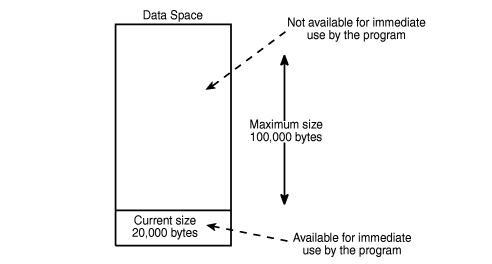- An installation can set limits on the amount of storage available for each address space for all data spaces and hiperspaces with a storage key of 8 through F. If your request for this kind of space (either on the DSPSERV CREATE or DSPSERV EXTEND) would cause the installation limit to be exceeded, the system rejects the request with a nonzero return code and a reason code.
- An installation sets a default size for data spaces and hiperspaces; you should know this size. If you do not use the BLOCKS parameter, the system creates a data space with the default size. (The IBM® default size is 239 blocks.)
The data spaces and hiperspaces your programs create have a storage key greater than 7. The system adds the initial size of these spaces to the cumulative total of all data spaces and hiperspaces for the address space and checks this total against the installation limit. For information on the IBM defaults, see Can an installation limit the use of data spaces and hiperspaces?.
- The maximum size identifies the largest amount of storage you will need in the data space.
- An initial size identifies the amount of the storage you will immediately use.
As you need more space in the data space or hiperspace, you can use the DSPSERV EXTEND macro to increase the available storage. The amount of available storage is called the current size. (At the creation of a data space or hiperspace, the initial size is the same as the current size.) When it calculates the cumulative total of data space and hiperspace storage, the system uses the current size.
If you know the default size and want a data space or hiperspace smaller than or equal to that size, use the BLOCKS=maximum size or omit the BLOCKS parameter.
If you know what size data space or hiperspace you need and are not concerned about exceeding the installation limit, set the maximum size and the initial size the same. BLOCKS=0, the default, establishes a maximum size and initial size both set to the default size.
If you do not know how large a data space or hiperspace you will eventually need or you are concerned with exceeding the installation limit, set the maximum size to the largest size you might possibly use and the initial size to a smaller amount, the amount you currently need.
Use the NUMBLKS parameter to request that the system return the size of the space it creates for you. You would use NUMBLKS, for example, if you did not specify BLOCKS and do not know the default size.
DSPSERV CREATE,. . .,BLOCKS=(DSPMAX,DSPINIT)
.
DSPMAX DC A((100000+4095)/4096) DATA SPACE MAXIMUM SIZE
DSPINIT DC A((20000+4095)/4096) DATA SPACE INITIAL SIZE
As your program uses more of the data space storage, it can use DSPSERV EXTEND to extend the current size. Extending the current size of a data space describes extending the current size and includes an example of how to extend the current size of the data space in Figure 1.